Page 3
~ The Study of Threes ~
http://threesology.org
| pg 1 | pg 2 | pg 3 | pg 4 | pg 5 |
The earliest known records of the Nine Muses are from Boeotia, the homeland of Hesiod. Some ancient authorities thought that the Nine Muses were of Thracian origin. There, a tradition persisted that the Muses had once been three in number.
In the first century BC, Diodorus Siculus cited Homer and Hesiod to the contrary, observing:
Writers similarly disagree also concerning the number of the Muses; for some say that there are three, and others that there are nine, but the number nine has prevailed since it rests upon the authority of the most distinguished men, such as Homer and Hesiod and others like them.
Diodorus states (Book I.18) that Osiris first recruited the nine Muses, along with the satyrs, while passing through Aethiopia, before embarking on a tour of all Asia and Europe, teaching the arts of cultivation wherever he went.
According to Hesiod's account (c. 600 BC), generally followed by the writers of antiquity, the Nine Muses were the nine daughters of Zeus and Mnemosyne (i.e., "Memory" personified), figuring as personifications of knowledge and the arts, especially literature, dance and music.
The Roman scholar Varro (116–27 BC) relates that there are only three Muses: one born from the movement of water, another who makes sound by striking the air, and a third who is embodied only in the human voice. They were called Melete or "Practice", Mneme or "Memory" and Aoide or "Song". Three ancient Muses were also reported in Plutarch's (46–120 AD) Quaestiones Convivales[8] (9.I4.2–4).
However, the classical understanding of the Muses tripled their triad and established a set of nine goddesses, who embody the arts and inspire creation with their graces through remembered and improvised song and mime, writing, traditional music, and dance. It was not until Hellenistic times that the following systematic set of functions was assigned to them, and even then there was some variation in both their names and their attributes:
- Calliope (epic poetry),
- Clio (history),
- Euterpe (flutes and lyric poetry),
- Thalia (comedy and pastoral poetry),
- Melpomene (tragedy),
- Terpsichore (dance),
- Erato (love poetry),
- Polyhymnia (sacred poetry),
- Urania (astronomy).
According to Pausanias in the later second century AD, there were originally three Muses, worshipped on Mount Helicon in Boeotia: Aoide ("song" or "tune"), Melete ("practice" or "occasion"), and Mneme ("memory"). Together, these three form the complete picture of the preconditions of poetic art in cult practice.
In Delphi three Muses were worshiped as well, but with other names: Nete, Mese, and Hypate, which are assigned as the names of the three chords of the ancient musical instrument, the lyre.
Alternatively, later they were called Cephisso, Apollonis, and Borysthenis, names which characterize them as daughters of Apollo.
In a later tradition, a set of four Muses were recognized:
- Thelxinoë, ("The heart delighting"; the youngest of the group.)
- Aoide/Aoede, ("Song"; One of the three Elder Muses, together with Melete and Mneme. They are children of Uranus and Gaea and belong to the Titan generation of gods... yet all of them are also referred to as daughters of Zeus.)
- Arche, ("Beginning")
- Melete, ("Contemplation and Ponder")
Wikipedia: Muses

Hence, we end up with the numbers 3,4,7,9. Not 2, not 1, not 5, not 6, not 8, not 10 or more... though such may have been mentioned from time to time as displayed in the above image describing ten muses, but most other accounts of variable quantities did not get recorded.
Note that the previous list of 9 muses explicitly lists four who use language, while in the list after this group ,all of them except for the 3rd selection, "Erato", involves the voice, or at least implies it... but that the topic of hearing and thinking are not prominently delineated though they are very much a part of the ensemble, since speaking or using the voice implies both hearing and thinking... though I am sure some reader might want to interject some comical argument about this regarding a particular context. While the former list is occupationally ascribed to giving reference to some physical attribute involving appearance, the second one gives each of the characters a more definite ability. The former might well be interpreted to be that illustrated by the personal interests shown by many women (and men), the second might well be a male generated list of descriptions. It is like reviewing the differences between the girl scout (called "brownies" due to the ugly brown uniforms that they wear), and the boy scout manuals. There is a stark difference in organization and overall layout... at least this is what I recall from looking at the different manuals several decades ago... though they may have substantially changed to date, and I have not perused to comment on.
The idea of the nine muses can be seen from different perspectives, as synonymously illustrated by three different approaches to photographing the same scene, as viewed in the following three images of the same subject. Each of them shows the three in a different light:
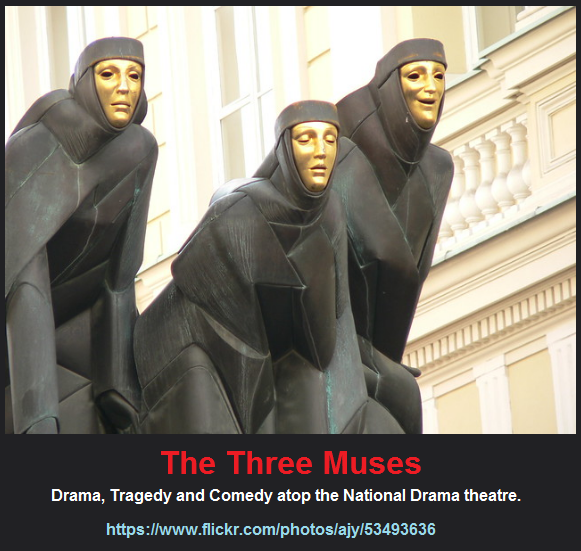 |
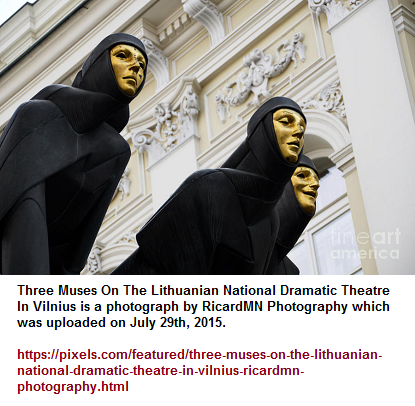 |
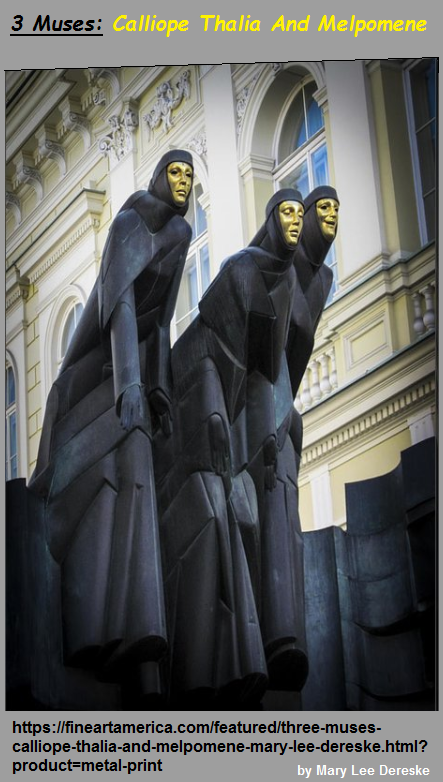 | |
While 3 forms of theatre are displayed, a fourth item is sometimes considered, which we might want to consider as a 3-to-1 ratio since it is a mixture of the first two:
There are four main forms of drama. They are comedy, tragedy, tragicomedy and melodrama. All these types have the common characteristics of drama genre; they are, plot, characters, conflict, music and dialogue. (4 types of drama in literature by Rose Allah.
Along with a discussion of the three Muses, we have yet another formula of three attached the Theatre called the "Three Unities". Because it combines a reference to singularity, or single event we have a 3 to 1 ratio:
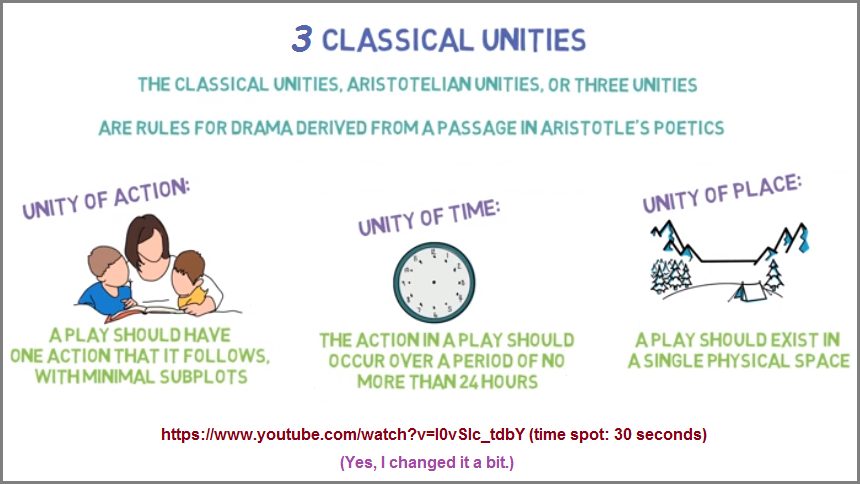
In drama, the (Three Unities) were the three principles derived by French classicists from Aristotle's Poetics; they require a play to have a single action represented as occurring in a single place and within the course of a day. These principles were called, respectively, unity of action, unity of place, and unity of time.
These three unities were redefined in 1570 by the Italian humanist Lodovico Castelvetro in his interpretation of Aristotle, and they are usually referred to as "Aristotelian rules" for dramatic structure. Actually, Aristotle's observations on tragedy are descriptive rather than prescriptive, and he emphasizes only one unity, that of plot, or action.
In the French classical tragedy, the unities were adhered to literally and became the source of endless critical polemics. Disputes arose over such problems as whether a single day meant 12 or 24 hours and whether a single place meant one room or one city. Some believed that the action represented in the play should occupy no more time than that required for the play's performance—about two hours. In spite of such severe restrictions, the great 17th-century French dramatists Pierre Corneille and Jean Racine, confining the crises of their characters' lives to a single setting and a brief span of hours, produced a unique form of tragedy that derives its austere power from its singleness of concentration. The prestige of the unities continued to dominate French drama until the Romantic era, when it was destroyed, in an evening of catcalls and violence, with the opening of Victor Hugo's Romantic tragedy Hernani (1830).
In England, where playwrights often had two or more plots in a play, comedy and tragedy were mixed and the setting switched to "another part of the forest" freely; the unities were esteemed in theory but ignored in practice.
Source: "unities." Encyclopædia Britannica Ultimate Reference Suite, 2013.
You may also like: Wikipedia: Classical unities which provides the following excerpt said to be from Plato's Poetics from which the idea of Action is derived, and yet it is really silly to discount the presence of time and place since an action must have a time and place and are thus expressed if not in the particular, then by way of referenced accountability that we of today might well describe as a type of common sense that is taken for granted:
Tragedy, then is a process of imitating an action which has serious implications, is complete, and possesses magnitude. ...A poetic imitation, then, ought to be unified in the same way as a single imitation in any other mimetic field, by having a single object: since the plot is an imitation of an action, the latter ought to be both unified and complete, and the component events ought to be so firmly compacted that if any one of them is shifted to another place, or removed, the whole is loosened up and dislocated; for an element whose addition or subtraction makes no perceptible extra difference is not really a part of the whole.
It also is rather silly to discount the presence of the three unities, try as many might wish to express some form of adolescent-like rebelliousness to former parents of the theatre. Even Heisenberg's Uncertainty Principle has time, place and action, whether or not it accounts for the difficulty in making an account of that which is given the impression of being a sprite... perhaps thus revealing an unintended projection of a prevailing inclination of humanity to fear that which is not known very well, and thus helps humanity avoid confronting the fear by claiming it as possessing some god-like invisibility or changeling attribute.
In the short discussion of the muses herein undertaken, let us add to it by making mention of another enumerated lineup of considerations involving both literature and theatrical performances:
Nine basic plots: (The Seven...Actually Nine Basic Plots According to Christopher Booker By Glen C. Strathy)
- Overcoming the Monster
- Rags to Riches
- Failure
- Hollow victory
- Quest
- Voyage and Return
- Comedy
Traditionally, comedy has been defined in several ways.
- As any story that ends happily.
- As a story which is humorous or satirical.
- With New Comedy or Romantic Comedy: as a drama about finding true love (usually young love).
Booker's 3 stages of Comedy:
- The story takes place in a community where the relationships between people (and by implication true love and understanding) are under the shadow of confusion, uncertainty, and frustration.
- The confusion worsens until it reaches a crisis.
- The truth comes out, perceptions are changed, and the relationships are healed in love and understanding (and typically marriage for the hero).
- Tragedy
- Mystery
- Rebellion Against 'The One'
Addressing the different themes one uncovers in the different genres of storytelling with and without supportive anthropological, archeological or other evidence except the routinization of usage for a given people or culture or time period, nonetheless provides some insight in human cognitive processing. In calling attention to the "many genres of storytelling" phrase by the use of quotation marks, I want to assert that all forms of expression are types of story telling, though they may not customarily be labeled as such. This includes the "hard" sciences such as physics, biology, mathematics, etc... All of them are stories with their individualized types of truth. However, in examining such genres of thinking as stories, one should make an effort to exam storytelling from more in depth efforts of analysis as well as become accustomed with the multiple kinds of stories being written from different perspectives which may or may not involve the usage of scientific or mathematical or biological data; since so very many exhibit an inclination to some type of psychology or psychological disposition. Here is one approach to examining different types of story-telling: 100 types of stories by Seth Singleton.
There are other lists as seen here which exceed the 9 quantity: , and if we were to add in peculiarities of different cultures who might well claim that any attempt to understand or appreciate their ideas would be (conveniently?) said to be "lost in translation", we might well have a list of thousands of characters. However, despite the many labels, no doubt there are but a handful of basic themes or described as The seven basic plots:
- Overcoming the Monster
- Rags to Riches
- The Quest
- Voyage and Return
- Comedy
- Tragedy
- Rebirth
Interestingly, the above list is followed by a reference to the "Rule of Three":
"Again and again, things appear in threes . . ." There is rising tension and the third event becomes "the final trigger for something important to happen". We are accustomed to this pattern from childhood stories such as Goldilocks and the Three Bears, Cinderella, and Little Red Riding Hood. In adult stories, three can convey the gradual working out of a process that leads to transformation. This transformation can be downwards as well as upwards. Booker asserts that the Rule of Three is expressed in four ways:
- The simple, or cumulative three, for example, Cinderella's three visits to the ball.
- The ascending three, where each event is of more significance than the preceding, for example, the hero must win first bronze, then silver, then gold objects.
- The contrasting three, where only the third has positive value, for example, The Three Little Pigs, two of whose houses are blown down by the Big Bad Wolf.
- The final or dialectical form of three, where, as with Goldilocks and her bowls of porridge, the first is wrong in one way, the second in an opposite way, and the third is "just right".
Since "Booker" is not a Threesologist, he may well not be familiar with the types of three he is clumsily giving reference to. For example:
- The first example might well be viewed in terms of a serration or evolutionary expression defined by time, though it can also suggest a 3-in-1 ratio. However, a degradation of time might be interpreted from an atomic particle perspective.
- The second example also conveys a sense of progression to which a biological or mechanistic metaphor might be applied.
- This third example as he states it, reminds me of the rock- paper- scissors betting theme that can never quite achieve a unity in the sense of overlapping to create a symbioses. Such images are not routinely advanced either by those writing stories or projecting storied material onto the theater, music genres nor motion pictures. They typically think very simplistically in "threes" like primitive undertakings in the development of a words-for-numbers expression.
- The last one in this series, thus itself expressing what might be viewed as a 3-to-1 accumulation; does in fact portray an unconscious recognition for the practice of a 3-to-1 grouping, to be differentiated from the 3 "and" 1 or 3 "in" 1 formulas, though various other conjunctive words might be parenthetically inscribed or inserted as well.
Booker doesn't describe the presence of complex formulas, or cumulative forms such as the "nine" muses which have on occasion been reduced to three. Nor does he provide a reference to a "one" which incorporates a three structure whose development was lost over time, which might have been the case if, for example, Eve, of the Three Faces of Eve, had continued to develop here overall three-patterned personality as a single entity in an environment which permitted such a development... and that such characters do in fact exist but conventions of observing behavior do not routinely recognized this. While hosts of psychologists, psychiatrists, and other keen observers of human behavior recognize this with their own variations of interpretation, it is not a common perspective introduced into daily conversations or displayed by the conventionalities of day to day writers of journalism. Most of us are inclined to think that present behavior of humanity is normal, though the psychotic, neurotic, barbaric, crude, etc., peoples of the past held the same opinion for themselves.
In the above rendition of Booker's "three" reference, it displays a lack of understanding the dynamics of "threes" cast with the wider net of being associated with the basics of multiple subjects such as mathematics, physics or even the games of chase and tag, not to mention the combinations such as the 2-3-4, 3-4-5, and other ensembles. While some might want to argue that human behavior retains an inclination to exhibit simple formulas of "three", this is only true if you believe that most writers have a grasp of the "three" and are intelligently observant of human behavior beyond the stereotypes regurgitated by those wanting to make a quick buck by appealing to simplistic sensibilities that are rewarded for remaining as such. Denying the existence of complexity, a word not even described in the above list of Bookers "threes" renditions, does not make them non-existent. It only makes them concealed under a barrage of idiocy being used by and taught to writers, and must therefore be described as writing basics, but is more aptly described as the basic writing of those trained in the same idiocy. This nonsense is readily seen when in the discussion of patterns found in folklore and fairy tales, of which many have originated in an oral tradition and kept alive by an active effort of "cerebralality" (cerebral reality) through memorization... though it tends to be altered over time.
Specifically, while many stores have patterns other than the "three", the "three" is a well-known theme amongst those studying children's literature, with an emphasis on fairytales. Many writers use either the "three" as a bold expression or as a layout theme that is not overtly given attention to, and think to use it as a presumed subtly that was at one time referred to as a subliminal message. However, this of course implies that there is a level of attention that is taking place in addition to that described as conscious awareness, which some might label as an unconscious awareness. And yet, with these two we might also include the idea of a hyper awareness, that several people have exhibited, and should be differentiate from that reviewed as Hyper-vigilance, very often seen being exhibited by those who keep a lookout for some potential danger in their surroundings. Necessarily so, from the idea of three types of consciousness to go along with three divisions of the brain (hindbrain- midbrain- forebrain), we might at some time venture into thinking about thoughts and thought processing, which we may want to think exhibits a basic three-part syllogistic formula such as Major premise- Minor premise- Conclusion, or have our ego "up the ante" and create the idea of multiple forms of thought and also multiple forms of intelligence... which again smells of a French perfume odor to me in that this describes an inclination towards adopting a plurality that I shall note as a soap-opera interest as opposed to seeking an actual means of developing a tool for measurement. It is a perspective not only seen in the Tour de France (where the course each year is different from the year before, thus disabling any attempts to measure athlete performance over the same course and instead the French are more interested in the overall socialization and commercialization of the professional cycling sport); but is also seen in the origination of Sociology by the French, though the named Father of Sociology Auguste Comte (1798–1857), did make an an attempt at devising a three-patterned law of thought progression, but did not try to apply this either to an analysis of the occupations of the muses, or the occupations of those in the guild system, or those ideas being promoted as basic themes by writers:
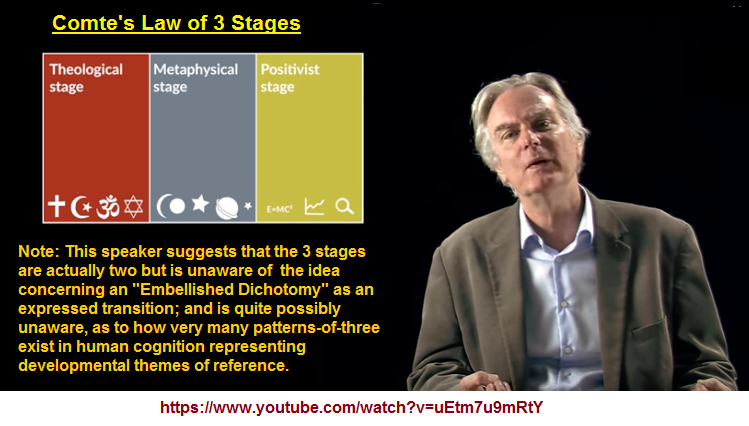
The Law of the Three Stages of the Human Mind
However, let us note that when a step in the direction of making correlations is addressed such as in the case where the idea of a multi-disciplinary approach is undertaken, there remains a lack of coordination. Trying to combine the different characteristics of ideas and attached personalities of the people involved is imagined as difficult as it may have been for the development of the basic cell billions of years ago which incorporated different constituent functionalities called organelles... which, by the way, have not been aligned into a cohesive singularity as is suggested by being a part of a single cell's enclosure that has forced a compromise of inter-relatedness but has not evolved beyond this stage of primitive design. In other words, it retains that which was designed countless ages ago and has not evolved into a new entity— just as the Triplet codes of DNA and RNA have not moved on to some other formulation. This is indeed problematic because it may mean that multiple efforts by humans may have an underlying "stop codon" so-to-speak, which prevents it from transgressing beyond a proscribed domain.
If we bring to the fore the idea of brevity, which is analogically consistent with the idea of a small and repeating code:
In linguistics, Brevity law (also called Zipf's law of abbreviation) is a linguistic law that qualitatively states that the more frequently a word is used, the 'shorter' that word tends to be, and vice versa. This is a statistical regularity that can be found in natural languages and other natural systems and that claims to be a general rule.
Brevity law was originally formulated by the linguist George Kingsley Zipf in 1945 as a negative correlation between the frequency of a word and its size. He analyzed a written corpus in American English and showed that the average lengths in terms of the average number of phonemes decreases as the frequency word increases. He completed this observation showing that, for a Latin corpus, there is a negative correlation between the number of syllables and the frequency of appearance of words. This observation says that the most frequent words in a language are the shortest, e.g. the most common words in English are:
- the
- be (in different forms)
- to
- of
- and
- a
All of them short words that contain only 1 to 3 letters.
He claimed that this Law of Abbreviation is a universal structural property of language, hypothesizing that it arises as a result of individuals optimizing form-meaning mappings under competing pressures to communicate accurately but also efficiently.
Since then, the research on this linguistic law has continued and it has been empirically verified for almost a thousand languages of 80 different linguistic families when studying the relationship between the size of words measuring them in terms of number of characters in texts and their frequencies. The Brevity law shows to be universal and has also been observed acoustically when word size is measured in terms of word time duration,[5] and recent evidence even suggests that this law also holds in the acoustic communication of other primates.
The origin of this statistical pattern seems to be related to optimization principles and derived by a mediation between two major constrains: the pressure to reduce the cost of production and the pressure to maximize transmission success. This idea is very related with the principle of least effort, which postulates that animals, people, even well-designed machines will naturally choose the path of least resistance or "effort". This principle of reducing the cost of production might also be related to principles of optimal compression of based in information theory.
In the above highlighted red sentence, one must wonder if the genetic code arises as a result of Nature optimizing form/structure -meaning mappings under competing pressures to communicate accurately but also efficiently? Are the patterns seen in language a metaphor for physical and smaller biological dimensions of occurrence?
The next item in the lineup of this discussion is the related Principle of Least Effort:
The principle of least effort is a broad theory that covers diverse fields from evolutionary biology to webpage design. It postulates that animals, people, even well-designed machines will naturally choose the path of least resistance or "effort".
If this holds true in all dimensions of activity like the activities of the LGBTQers, celibates, sedentary life styles, etc., ... and even that which we call aggression from one culture to the next, seeks the path of least resistance, including the biological activities of genetics, then the triple codon system is an expression of both the "Brevity" and "Least Effort: ideas, which offers an argument against the notion "The Survival of the Fittest", unless cowardice in the face of resistance is how many things are sustained from one generation to the next... by way of a "passive aggressiveness", so to speak. In running away or diverging away from stress, we topple and run over those who are weaker but trying to do the same... like adults trampling over the old, infirmed as well as children in a headlong retreat and use various rationalizations to justify their actions that come into scrutiny later one... or are excused indefinitely by a world-view such as having a philosophy which guarantees the lawfulness of killing children due to some psychotically driven ideology of preservation for the greater good. If the triplet code was brought into being and is sustained by an underlying activity of a designed brevity as the result of a "least effort" principle, then what is that which is causing such a design, and is it immutable, or subject to change itself? No less, is this that is causing it, an expressed brevity an object/item which itself also likewise follows a "least effort" pathway? Does each least effort expression lead to one that is even a lesser effort... thus bringing about a type of inversion to be noted as a black hole?
Then again, acts of "brevity" and "least effort" can be camouflaged by appearances suggesting lengthiness and much effort such as by way of duplications and creating or looking for activities that would give the appearance of opposition but actually lack the underlying wherewithal to prevent subjugation by someone or something that is a superior form of weakness taking advantage of an inferior form of weakness. Like a team of adults whose weight and experience of human behavior make them able to surmount the actions of youth in a sports match-up. Or an army intentionally losing a battle to make another army over-confident enough to lower their guard, whereby they are made vulnerable and more easily subdued under such circumstances. A passive strategy over an aggressive one can be more effective under conditions which favor such a strategy that may have to be set into place in order to permit such a strategy to be effective. For example, in genetics, the retention of vestigial forms and functionality remain by some mechanism which prevents them from being completely removed from a species, as if past changes in the environment made such forms and functions viable from time to time. Like a frog which buries itself in mud awaiting a rainy season, or other migrations of biological activity which either seek out, construct or wait for more favorable conditions.

Since life is briefer than death, yet death appears to be the path of least resistance, what are we then confronted with? Another paradox? Or is it a bubble? A flat surface which can bring forth a bubble, to which some have mused on whether atomic particles can emerge on the "flatness" of space and the darkness is like a dirty pool of water giving rise to various suppositions like peering into a dark cave can well evoke imaginings.
As an analogy to the idea of a path along least resistance as well as brevity, we find many occurrences taking place in patterns-of-three in one context such as that of Earth and its three typical forms of heat radiation, and then add to it that form said to be occurring between to points within a vacuum, such as particles in the vacuum of space, not to mention 3 types of radiation:
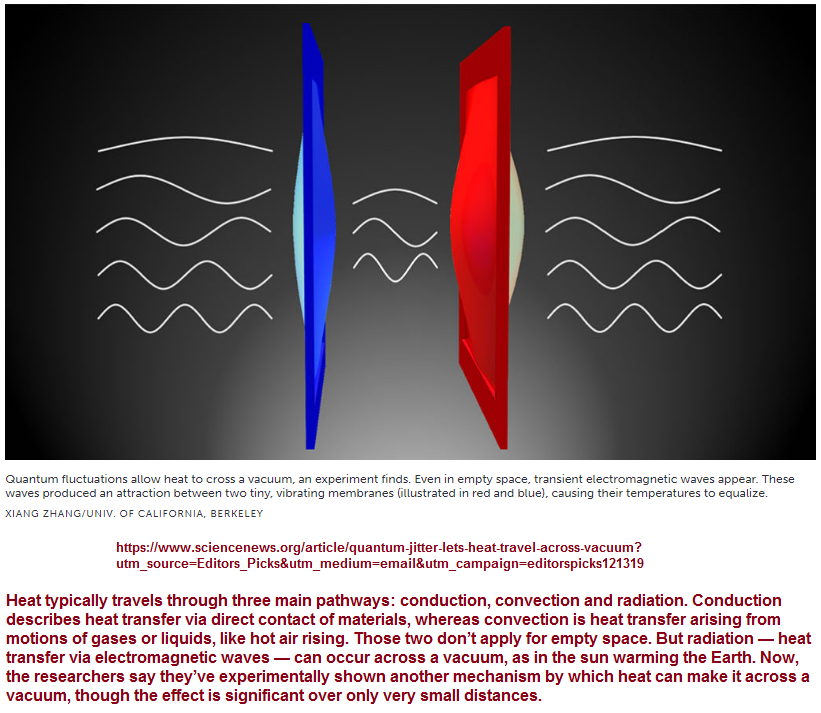
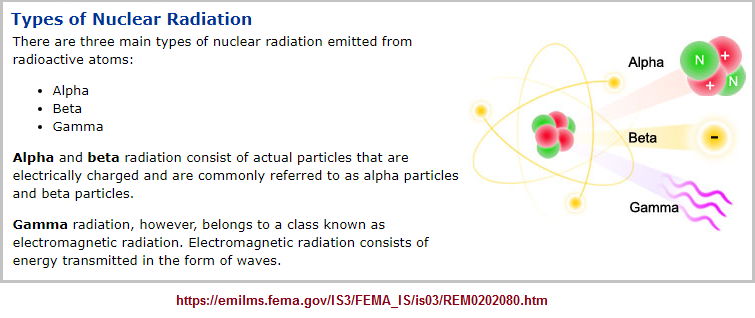
Origination date: Monday, December 2nd, 2019... 5:47 AM
Initial Posting: Thursday, December 26th, 2019... 9:54 AM
Updated Posting: Tuesday, February 7th, 2023... 10:43 AM
Herb O. Buckland
herbobuckland@hotmail.com